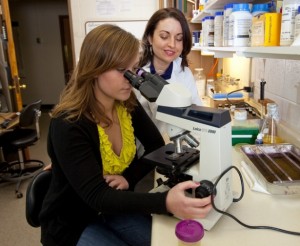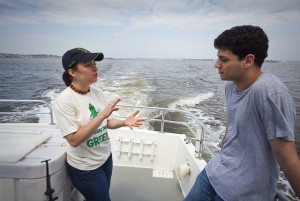
Professor Megan Rothenberger, right, works in the lab with Alyssa Calomeni '11.
Some professors might be alarmed if they saw college students running toward them with a dripping net filled with slimy creatures, but not Megan Rothenberger ’02.
“It’s really rewarding for me to see students get excited about discoveries they make in the lab or out in the field,” she says. “When they realize that something that looks like elephant snot in a stream actually looks like miniature green and gold gems under the microscope, or when they run at me with a dip net filled with crayfish or tadpoles to show me what they found, I love it!”
While Rothenberger knew she wanted to be a biology major at Lafayette, she quickly realized that a life of lab coats and test tubes wasn’t for her. When she took botany, ecology, and marine biology classes in her sophomore year, her career as a conservation biologist was born.
Rothenberger sat enthralled in class when Lorraine Mineo, the since-retired general biology laboratory coordinator, held up a BioScience journal with a black and white photo of a peculiar protist (a kind of unicellular organism) with whip-like tails and told the class it was discovered by scientists at North Carolina State University. The blooms the organism formed in coastal ecosystems were causing fish kills and releasing a neurotoxin that made fisherman sick.
“I knew at that moment I wanted to be part of that research,” says Rothenberger, who earned her Ph.D. in aquatic ecology at North Carolina State University, Raleigh. “I was attracted to conservation biology because it is an interdisciplinary and applied field. I like the fact that the work being done in my lab can be understood by most people.”
Case in point: When she and her students – Rothenberger returned to Lafayette as assistant professor of biology in 2009 – are out in the field, concerned fisherman and community members often approach them with questions.
“They ask us, ‘Are you looking for that Asian crab that’s taking over blue crab habitat?’ or ‘Does that machine you’re using measure oxygen? It’s low because of the pollution, right? There’s just not as many fish as there used to be,'” she says. “Because they have been witness to environmental change and degradation, they get the gist of what we are trying to do. I like that.”

Professor Megan Rothenberger works with Raphael Cuomo ’11 at Raritan Bay, N.J.
Interactions like those are why Rothenberger stresses the need for quality communication in her classes. Three of the four courses she teaches – Conservation Biology, Environmental Issues in Aquatic Ecosystems, and Agriculture, Ethics, and the Environment – are writing courses.
“In my opinion, there is no point in conducting scientific investigations if you can’t effectively communicate the results of your work to the people who will benefit from it or who can use it to make some positive change,” she explains.
Remembering how much her independent study and honors thesis research benefited her once she got to graduate school, Rothenberger strives to be a mentor for her students, involving them in research that they can present and publish. She briefly taught at a large university, where she saw just how few students had that one-on-one research opportunity with faculty. It’s a valuable give and take.
“When students challenge me with questions I don’t know, we all get to learn something new together,” she says. “I also love the fact that each semester brings a new batch of students with new ideas and perspectives and a new class dynamic.”
Rothenberger keeps plenty of research plates spinning. She has three ongoing projects involving student researchers. Alyssa Calomeni ’11 completed honors thesis research and Danielle Sobol ’12, Carolyn Cabrey ’12, Andrew Chun ’12, and Alex Pong ’13 are conducting independent study research to investigate different aspects of water quality in Raritan Bay, N.J. Carly Feiro ’12 is collecting and analyzing macroinvertebrates from five dam sites along the Bushkill Creek as part of a multidisciplinary research endeavor involving multiple student teams to study the effects of dam removal along the creek. Raphael Cuomo ’11 also worked on the project. Shane Foye ’12 is continuing work begun by Jeff Hollander ’11 by studying the impact of two biocontrol beetles on purple loosestrife plants within Jacobsburg State Park.
“Even if they remember nothing else, I hope they remember our lab motto, which is ‘Experience is what you get when you don’t get what you want,’” Rothenberger says. “Research projects – and life – rarely happen the way we envision them, but problems and setbacks can be opportunities. I believe it’s really important to be adaptable and perseverant, keep an open mind, and continue searching for creative solutions in the face of those problems.”

